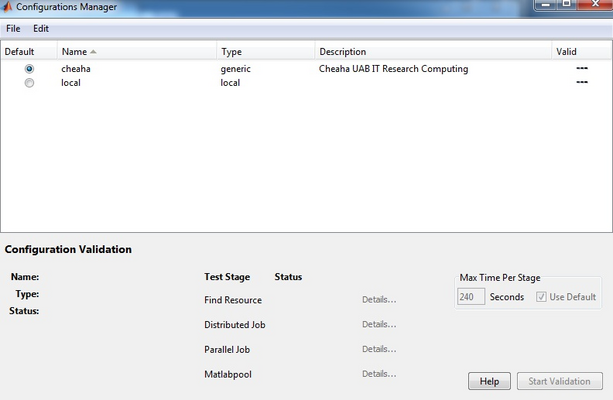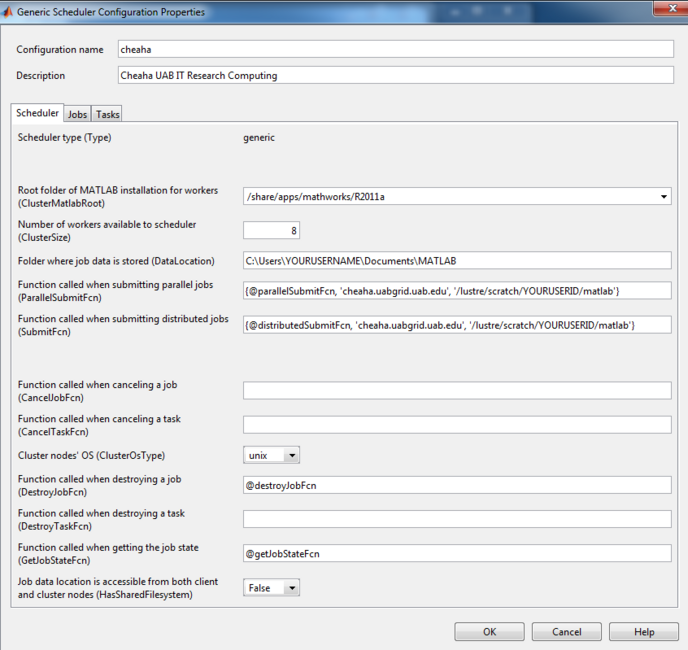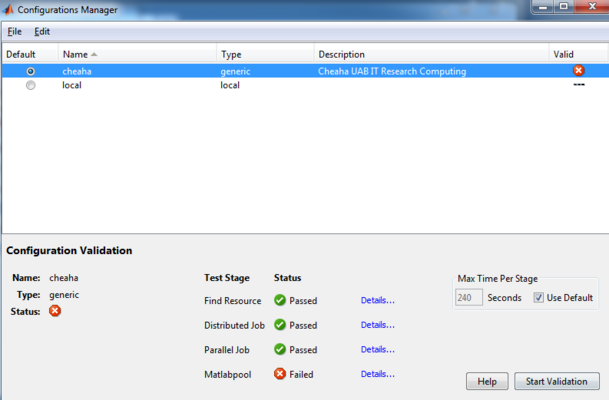MATLAB workshop 2011: Difference between revisions
(added text at the beginign to inform about the changes in R2012a) |
|||
| (3 intermediate revisions by the same user not shown) | |||
| Line 1: | Line 1: | ||
'''Presenter - Thomas Anthony''' | |||
'''UAB IT Research Computing''' | |||
'''tanthony@uab.edu''' | |||
The following instructions and code have been tested and verified on Matlab R2010b, R2011a, and R2011b. The instruction for installation and some code needs to be modified because of the changes introduces in R2012a. | |||
==Introduction == | |||
'''[[wikipedia:MATLAB|MATLAB]]''' ('''mat'''rix '''lab'''oratory) is a [[wikipedia:Numerical analysis|numerical computing]] environment and [[wikipedia:fourth-generation programming language|fourth-generation programming language]]. Developed by [[wikipedia:MathWorks|Mathworks]], MATLAB allows [[wikipedia:matrix (mathematics)|matrix]] manipulations, plotting of [[wikipedia:function (mathematics)|functions]] and data, implementation of [[wikipedia:algorithm|algorithm]]s, creation of [[wikipedia:user interface|user interface]]s, and interfacing with programs written in other languages, including [[wikipedia:C (programming language)|C]], [[wikipedia:C++|C++]], and [[wikipedia:Fortran|Fortran]]. An additional package, [[wikipedia:Simulink|Simulink]], adds graphical multi-domain simulation and [[wikipedia:Model based design|Model-Based Design]] for [[wikipedia:dynamical system|dynamic]] and [[wikipedia:embedded systems|embedded systems]]. | '''[[wikipedia:MATLAB|MATLAB]]''' ('''mat'''rix '''lab'''oratory) is a [[wikipedia:Numerical analysis|numerical computing]] environment and [[wikipedia:fourth-generation programming language|fourth-generation programming language]]. Developed by [[wikipedia:MathWorks|Mathworks]], MATLAB allows [[wikipedia:matrix (mathematics)|matrix]] manipulations, plotting of [[wikipedia:function (mathematics)|functions]] and data, implementation of [[wikipedia:algorithm|algorithm]]s, creation of [[wikipedia:user interface|user interface]]s, and interfacing with programs written in other languages, including [[wikipedia:C (programming language)|C]], [[wikipedia:C++|C++]], and [[wikipedia:Fortran|Fortran]]. An additional package, [[wikipedia:Simulink|Simulink]], adds graphical multi-domain simulation and [[wikipedia:Model based design|Model-Based Design]] for [[wikipedia:dynamical system|dynamic]] and [[wikipedia:embedded systems|embedded systems]]. | ||
In January 2011, UAB acquired a [[2011_UAB_MATLAB_site_license_software | site license]] for MATLAB that allows faculty, staff, post-docs, and graduate students to use MATLAB, Simulink, and 42 toolboxes (including the parallel toolbox) for research activities on campus and personal systems. Additionally, MATLAB is available to students on campus computer systems. | In January 2011, UAB acquired a [[2011_UAB_MATLAB_site_license_software | site license]] for MATLAB that allows faculty, staff, post-docs, and graduate students to use MATLAB, Simulink, and 42 toolboxes (including the parallel toolbox) for research activities on campus and personal systems. Additionally, from January 2012 MATLAB is available to students on campus and personal computer systems. | ||
== Install and Configure MATLAB == | == Install and Configure MATLAB == | ||
| Line 370: | Line 379: | ||
./matlabtest 10 | ./matlabtest 10 | ||
{{MATLAB Support}} | |||
[[Category:MATLAB]] | |||
Latest revision as of 14:13, 12 March 2012
Presenter - Thomas Anthony
UAB IT Research Computing
tanthony@uab.edu
The following instructions and code have been tested and verified on Matlab R2010b, R2011a, and R2011b. The instruction for installation and some code needs to be modified because of the changes introduces in R2012a.
Introduction
MATLAB (matrix laboratory) is a numerical computing environment and fourth-generation programming language. Developed by Mathworks, MATLAB allows matrix manipulations, plotting of functions and data, implementation of algorithms, creation of user interfaces, and interfacing with programs written in other languages, including C, C++, and Fortran. An additional package, Simulink, adds graphical multi-domain simulation and Model-Based Design for dynamic and embedded systems.
In January 2011, UAB acquired a site license for MATLAB that allows faculty, staff, post-docs, and graduate students to use MATLAB, Simulink, and 42 toolboxes (including the parallel toolbox) for research activities on campus and personal systems. Additionally, from January 2012 MATLAB is available to students on campus and personal computer systems.
Install and Configure MATLAB
Using Mathworks software available under the UAB campus license on your computer involves download and install steps common to all software packages and an authorization step that grants you the rights to use the software under the campus agreement.
Installation
Installation Overview
NOTE:These steps are common to all install scenarios and are detailed in Downloading and Installing MATLAB.
- Create an account at the Mathworks site using your campus @uab.edu email address.
- Request an activation key.
- Associate your Mathworks account with the campus-wide MATLAB license using your activation key.
- Download the software from the mathworks download site and install MATLAB. (Contact a MATLAB-TAH Asset Manager to get download rights)
- Activate the software using the activation scenario that best suits your particular needs.
Installation for Various Activation Scenarios
NOTE: Most on-campus users are encouraged to use the Simplified MATLAB Install option for activation unless there are special circumstances that require the alternative activation scenarios.
- Simplified MATLAB Install - This is the recommended install when MATLAB will be used on computers that remain connected to the campus network. This installation requires MatLab software to be installed on your computer and provides a simple 2-line file to activate the software. This option is highly recommend.
- Matlab Designated Computer Install - This option is recommended for mobile computing systems which may not have network access when MATLAB is being used. This install type authorizes an individual computer to run MATLAB, allowing MATLAB to run regardless of where the computer is located.
Configure MATLAB
Configuration Overview
Configuring the Parallel Computing Toolbox involves three steps documented below:
- install MATLAB submit functions on your workstation
- configure the "cheaha" parallel computing target to which PCT tasks can be submitted
- run the validation tests to confirm a working installation.
This page documents the DCS configuration for MATLAB 2010b and later. For DCS configuration instructions on previous versions of MATLAB, please see the page MatLab DCS R2010a and Earlier
Using MATLAB DCS requires you have a cluster account on Cheaha. Please request an account by sending an email to [[1]] and include your campus affiliation and a brief statement of your research interests for using the cluster.
MATLAB Submit Functions
The MATLAB submit functions create a cluster job context for your code and are responsible for transferring your code and the data it analyzes to the cluster for processing.
These submit functions must be installed on your computer and must be accessible to MATLAB via the MATLAB PATH environment. The easiest way to accomplish this is to copy the submit functions to the default directory created for by MATLAB. These directories on the respective operating systems are listed below.
- Download the MATLAB submit functions
- Submit Functions for MATLAB R2010b and later -(updated 02/21/2011)
- Unzip the files to a directory included in your MATLAB PATH setting. Recommended locations are:
- Windows:
My Documents\MATLAB
- Linux:
$HOME/Documents/MATLAB
- Mac:
$HOME/Documents/MATLAB
- Windows:
Once the submit function files have been downloaded and unzipped in the above paths, restart MATLAB to ensure they are properly loaded in your environment.
Parallel Computing Toolbox Configuration
The Parallel Computing Toolbox (PCT) enables language extensions in MATLAB that support dividing your application into tasks that can be executed in parallel. By default, all of these tasks will run on your local workstation using the pre-defined "local" PCT configuration.
To run these tasks on the Cheaha compute cluster, a new configuration for the PCT must be defined. In this section we will create the "cheaha" configuration and run a quick validation test to confirm its operation.
Prior to continuing, make sure you:
- can establish an SSH connection to Cheaha
- have followed the steps in the previous section
Create the "cheaha" PCT Configuration
- Download and save the Cheaha cluster configuration file in a file named "cheaha.mat".
- Start MATLAB on your workstation
- Click the "Parallel" menu
- Click "Manage Configurations"
- In the "Configurations Manager" window, click "File -> Import"
- Browse to the location where you saved the cheaha.mat file, select it, and click "Open"
The Configuration Manager should now list a new entry named "cheaha" as shown in the following image:
Personalize the "cheaha" PCT Configuration
- Double click on cheaha in the Configuration Manager window to open the configuration editor. (Note: stretch the "Generic Scheduler Configuration Properties" window to the right so that you can view all of the text in the fields making it easier to read and edit correctly.)
- Edit the following fields to use your personal data directories
- ClusterMatlabRoot: Make sure that the Root directory of MATLAB installation for workers matches the exact version of MATLAB you are using on your workstation. In this example /share/apps/mathworks/R2011a matches a MATLAB R2011a workstation install. Change the "R2011a" to match your workstation MATLAB install.
- DataLocation : Change the directory path where job data is stored to an existing directory on your workstation. For example, on Windows the directory C:\Users\<USERNAME>\Documents\MATLAB is created by default by MATLAB. Please confirm this directory is valid.
- ParallelSubmitFcn: Change the text "YOURUSERID" to your login id on Cheaha
- SubmitFcn : Change the text "YOURUSERID" to your login id on Cheaha
- Click 'OK'to save the configuration
The initial configuration will look similar to this screen shot. You will need to edit the fields as describe in the preceding steps before you can use the configuration. NOTE: be sure to replace the template user name settings "YOURUSERNAME" with the appropriate settings for your desktop and cluster account.
Validate the "cheaha" PCT Configuration
- Select Cheaha on the configuration manager page and click 'Start Validation'
- Wait for the validation to complete. This might take a few minutes and you ask for User credentials on Cheaha. All tests other than 'Matlabpool' validate on the Cheaha and the output is as shown.
Validation must pass the first three stages to use MATLAB on Cheaha.
Workshop Demo's
- Serial job
- Offload the serial job to Cheaha
- Convert serial job to parallel and run it locally
- Offload the parallel job to Cheaha
- Distributed Job
- Small shell script using MATLAB
Serial Job
localScript.m
tic
close all
% pre allocate space and variables
l=[];
c=1;
out=[];
diff=200;
% main working loop
check=90000:diff:91000;
for c=1:numel(check) % check no. of elements and feed to for loop
check(c) % display which loop is working
[l(c),count(c),ratio(c)]=primenofun(check(c)); % run function and get back output
end
final_time = toc
primenofun.m
function [l,count,ratios,q]=primenofun(final)
% preallocate variables
diff=200;
close all
count=[];
ratios=[];
l=[];
out=[];
start=0;
a=0;
% for loop
for i=start:final
c=isprime(i); %check if every number between start & final is prime
if c==1 % if it is , counts it as a prime number
i;
a=a+c;
end
end
a;
ratio=a/final; % gets the ratio of prime numbers to total numbers
l=[l,final];
count=[count,a]; % total count of prime numbers
ratios=[ratios,ratio];
out=[l',count',ratios']
Offload Serial Job to Cheaha using Submit Script
serialSubmit.m
%always set these variables
%matlab_ver = 'R2011b'; % (MATLAB release supported by your license) R2009a R2009b R2010a
email = 'YOUREMAILID'; % your email address
email_opt = 'a'; % qsub email options
h_rt = '1:07:00'; % hard wall time (time required to run this job)
vf = '2G'; % Amount of memory need per task
disp('Please wait.. Sending job data to the Cluster.... ')
% Configure the scheduler - Do NOT modify these
%sge_options = ['-l vf=', vf, ',h_rt=', h_rt,' -m ', email_opt, ' -M ', email, ' -q ' , queue ];
sge_options = ['-l vf=', vf, ',h_rt=', h_rt,' -m ', email_opt, ' -M ', email ];
SGEClusterInfo.setExtraParameter(sge_options);
sched = findResource();
% End of scheduler configuration
get(sched)
job1 = createJob(sched);
tic
% start of user specific commands (Please insert the m file to be submitted
% to Cheaha instead of USERmFILE and any other functions or files your
% scripts depends on in USERFUNCTION
job1 = batch('USERmFILE', 'FileDependencies', {'USERFUNCTION.m'});
disp('Job submitted..')
datestr(clock)
% The following commands can be run once the job is submitted to view the results
disp ('Job sent to the cluster')
disp('USE >> waitForState(job) to wait for job to be finished')
disp('USE >> job.State to see job state')
disp('USE >> load(job,variable) to load variables back in the workspace OR')
disp('USE >> results = getAllOutputArguments(job) to load variables back in the workspace AND')
disp('USE >> results{:} to see the results')
% waitForState(job2, 'finished');
% y = getAllOutputArguments(job2)
% datestr(clock)
% save newout.mat
%
% toc
Convert Serial Job to Parallel and run it locally
- Convert 'for' loop to a 'parfor'
- Start a matlabpool using 'matlabpool open local #no_of_workers' (General rule is no_of_workers = no. of processor cores available)
- Run the job
tic
close all
% pre allocate space and variables
l=[];
c=1;
out=[];
diff=200;
% main working loop
check=90000:diff:91000;
parfor c=1:numel(check) % check no. of elements and feed to for loop
check(c) % display which loop is working
[l(c),count(c),ratio(c)]=primenofun(check(c)); % run function and get back output
end
final_time = toc
Offload the Parallel Job to Cheaha
parallelSubmit.m
%always set these variables
%matlab_ver = 'R2011b'; % (MATLAB release supported by your license) R2009a R2009b R2010a
email = 'YOUREMAILID'; % your email address
email_opt = 'a'; % qsub email options
h_rt = '1:07:00'; % hard wall time
vf = '2G'; % Amount of memory need per task
%queue = 'sipsey.q' % specify queue
%min_cpu_slots = 15; % Min number of cpu slots needed for the job
max_cpu_slots = 7; % Max number of cpu slots needed for the job
disp('Please wait.. Sending job data to the Cluster.... ')
% Configure the scheduler - Do NOT modify these
%sge_options = ['-l vf=', vf, ',h_rt=', h_rt,' -m ', email_opt, ' -M ', email, ' -q ' , queue ];
sge_options = ['-l vf=', vf, ',h_rt=', h_rt,' -m ', email_opt, ' -M ', email ];
SGEClusterInfo.setExtraParameter(sge_options);
sched = findResource();
% End of scheduler configuration
get(sched)
job2 = createJob(sched);
tic
% start of user specific commands
job2= batch('USERmFile', 'matlabpool', max_cpu_slots, 'FileDependencies', {'USERFUNCTIONS'});
disp('Job submitted..')
datestr(clock)
% The following commands can be run once the job is submitted to view the results
disp ('Job sent to the cluster')
disp('USE >> waitForState(job) to wait for job to be finished')
disp('USE >> job.State to see job state')
disp('USE >> load(job,variable) to load variables back in the workspace OR')
disp('USE >> results = getAllOutputArguments(job) to load variables back in the workspace AND')
disp('USE >> results{:} to see the results')
% waitForState(job2, 'finished');
%
% y = getAllOutputArguments(job2)
% datestr(clock)
% save newout.mat
%
% toc
Distributed Job
distribSubmit.m
%always set these variables
%matlab_ver = 'R2011b'; % (MATLAB release supported by your license) R2009a R2009b R2010a
email = 'YOUREMAILID'; % your email address
email_opt = 'a'; % qsub email options
h_rt = '1:07:00'; % hard wall time
vf = '2G'; % Amount of memory need per task
%queue = 'sipsey.q' % specify queue
disp('Please wait.. Sending job data to the Cluster.... ')
% Configure the scheduler - Do NOT modify these
%sge_options = ['-l vf=', vf, ',h_rt=', h_rt,' -m ', email_opt, ' -M ', email, ' -q ' , queue ];
sge_options = ['-l vf=', vf, ',h_rt=', h_rt,' -m ', email_opt, ' -M ', email ];
SGEClusterInfo.setExtraParameter(sge_options);
sched = findResource();
% End of scheduler configuration
get(sched)
job3 = createJob(sched);
% start of user specific commands
diff=200;
for check=90000:diff:91000
%createTask(job3, @primenofun,4, {check});
createTask(job3, @USERFUNCTION,4, {check});
end
submit(job3);
disp('Job submitted..')
datestr(clock)
% waitForState(job2, 'finished');
%
% y = getAllOutputArguments(job2)
% datestr(clock)
% save newout.mat
%
Shell Script Using MATLAB
varpass.m
clc
clear all;
cmd='bash matlabtest';
output=[];
%fopen('output.txt','w');
for c=1:5
c;
a=sprintf('%d',c)
[status, out]=system([cmd,' ',a])
end
matlabtest
#!/bin/bash #echo "first parameter is $1" total=$(echo "scale=4; $1+2+3" |bc) #echo "Output $1 = $total" echo "$total" #$total
chmod +x matlabtest
./matlabtest 10
MATLAB Support / Mailing List
As with any application or computer language, learning to use MATLAB to analyze data or to develop or modify MATLAB applications is an individual responsibility. There is ample application documentation available from the Mathworks website, potential outreach to colleagues who also use MATLAB, and options for consultation with Mathworks. Mathworks also host on-campus training seminars several times a year and provides many on-line learning tutorials.
Installation support for MATLAB at UAB is provided by your local IT support organization and the Docs wiki.
Mathworks Website
Your first and best option for application-specific questions on MATLAB is to refer to the on-line MATLAB documentation. The Mathworks site also provides a a support matrix and an on-line knowledge base.
UAB MATLAB Wiki
The MATLAB page on the Docs wiki is the starting point for installing MATLAB at UAB and, optionally, configuring it to use cluster computing. All users are encouraged to contribute to the MATLAB knowledge in this wiki, especially if you see areas where improvements are needed. Remember, this knowledge base is only as good as the people who contribute to it.
Contributing to the wiki is as easy as clicking the login link on the top-right of the page and signing in with your UAB BlazerID. If you are unsure about making an edit, you can make suggestions for improvement on the page's Discussion tab or discuss the proposed improvement in the MATLAB user group.
UAB MATLAB User Group
At UAB, MATLAB installation support is provided by your local IT support group. Support for application specific questions is available from peers in your research group. We realize that some people are not as familiar with MATLAB as others. For this reason, we have established a MATLAB user forum (mailing list) where users of MATLAB at UAB can help answer each others questions.
This is a network of volunteers sharing their knowledge with peers. You are encouraged to reach out to this community for questions on using MATLAB by
- Joining the MATLAB user group - alternately send an email to sympa@vo.uabgrid.uab.edu with the following text in the body of the email subscribe matlab-user
- After joining the group, you can email questions to the group via matlab-user@vo.uabgrid.uab.edu
Archives of MATLAB user group discussions are available on-line at https://vo.uabgrid.uab.edu/sympa/arc/matlab-user. You may find your question is already answered in these archives.
UAB MATLAB announce mailing list
To receive information about UAB's MATLAB license and announcements please subscribe to the matlab-annc mailing list by
- Joining the MATLAB announce mailing list - alternately send an email to sympa@vo.uabgrid.uab.edu with the following text in the body of the email subscribe matlab-annc


